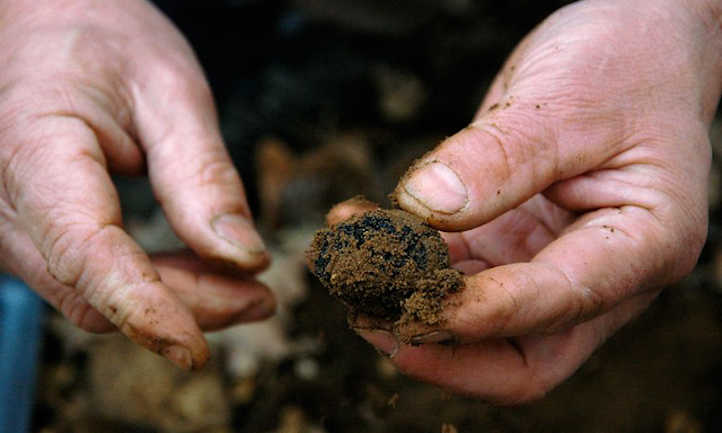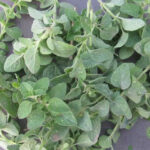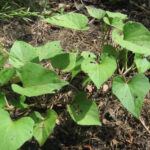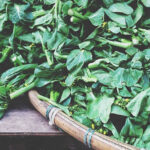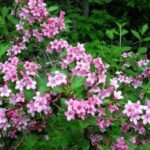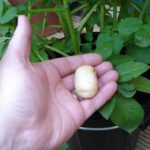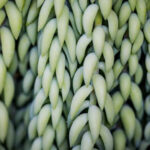Truffles may be new to many local restaurant menus, but these dark and fragrant fungi have actually been gracing plates and pots all over Europe since Roman times! Different from their cousin the mushroom in that they depend on animals and humans to disperse their spores, these delicious but odd-looking fungi are more than worth their weight in gold. While many types of truffles have never been domesticated (such as white truffles), there are three varieties of black truffles that have been successfully domesticated and now grow even here in the United States. Learning how to grow truffles was a long process that only came to fruition in the 1970s!
The first time I ever laid eyes on a truffle hunter was in the rolling hillsides of Pisa province in Italy while working on a farm. He wore a hunter’s hat, had a dog bounding after him, and carried a shotgun. My first thought was that he was a game hunter, going after the area’s pesky and marauding wild boars. The farmer I was working with instead told me, “No, he’s hunting truffles, the shotgun is for the thieves.” So precious are these truffles that much surrounding truffle growing and truffle hunting is shrouded in mystery.
Only in the last few decades has the mystery of the truffle started to come to light. We now know that truffles are spread by humans and animals and that truffles actually depend on us to survive and thrive. In pre-industrial times, and before the climate began to bring unusual rain patterns to their native Italian and French habitats, truffles were much more abundant. Human beings lived at the edge of homestead and wild, in villages spread out across the landscape.
Human activity, namely shepherding, collecting wood for fires, hunting, and traveling by foot meant that spores were often transported to new areas to colonize and grow. Additionally, the more frequent contact that humans had with nature increased their chances of finding pungent fungi. Our ways of living have changed, fewer people live at the edge of woodlands, and even fewer regularly use earthen woodland walkways on their daily meanderings, resulting in less spread and fewer encounters with these mouth-watering delicacies.
One thing that hasn’t changed is the demand for this delicious treat. White truffles, the type that is not farmable, can be found at auction selling for tens of thousands of dollars for just a pound or two. Usually, smaller ones cost less. This is expensive, especially when you take into account the fact that the truffle itself will only remain edible for a week before going bad! In fact, it was almost impossible to get fresh truffles in the United States until domestication happened.
After centuries of experimenting, three varieties of black truffles were domesticated in the 70’s meaning that growing truffles in the US is now possible. It’s not a quick-growing crop. In fact, this slow-growing fungi can take a while to appear because it is so dependent on the rootzones of other trees. Truffles grow beneath only specific trees such as oak and beech. It can take several years to colonize the roots of your truffle trees before the truffles attempt to reproduce and spread.
All About Truffles

The wonderful scent of the truffle can only be explained by its pheromones. These pheromones entice animals to come to dig around the base of the tree in search of the prize hidden there. Truffles are a type of fungi that live in the root system of certain trees. While there is a wide range of truffle subspecies, it’s easiest to split them up into white and black truffles. Three strains of black truffles have been domesticated, and farmers can now rely on them for a crop. White truffles are still wild and feral and only produce in the wild.
Truffles, or Tuber spp. occur naturally all over the world. However, the most famous European truffles are native to Alba, Italy, and bordering provinces of both Italy and France. While there are truffles native to places like Oregon in the United States, these truffles still suffer from a PR problem despite tasting as good if not better than some European truffles.
Truffle fungi grow in the rootzones of trees in symbiosis with the trees. They colonize the root zone and transmit nutrients from the soil to the tree. This happens when the fungus sends out hyphae and retrieves nutrients to feed the tree, and the tree in return produces food through photosynthesis that it shares with the fungus.
Trees and plants naturally engage in this reproductive process all over the world and with a wide range of mycorrhizae. It just so happens that this strain of mycorrhizae is delectable.
Thus, when growing truffles, you’re actually tending two different crops. You must first take care of the host tree and then tend to the secondary conditions that make truffle spores thrive so that they produce actual truffles.
In a typical growing season in an established orchard, the host trees will come out of dormancy in the spring and go through a growth spurt. Weeds and grass will try and encroach upon the truffles territory and must be hand-pulled or mechanically cut. During this time, truffle colonies are growing throughout the root zone, working to help the tree thrive. As summer and fall approach, if the truffle colonies have had the correct conditions, they’ll begin to produce what we recognize as truffles. Depending on the variety, the harvest season starts in summer and goes through late winter. The truffles require several months of steady rains (or irrigation), heat, and most importantly sunlight in the root zone to produce and then ripen. Once a truffle has ripened, it’s ready for harvesting with the aid of a truffle dog.
Truffles look like a cross between a black golf ball, and a lump of charcoal on the outside. The interior looks almost like corkboard and ranges in color from an off-white to all black. They’re most often found at harvest time by dogs, raking, or in centuries past by pigs!
Types of Truffles

The Bianchetto, or the ‘White Truffle’s Poor Relation’, is often mistaken for the white truffle with its off-white exterior. It looks somewhat like a lumpy white potato with dark brown splotches on it. The Tuber albidum pico is less fragrant than its more coveted cousin and has a harvest season of January to April.
The French Black Winter Truffle, the most famous of all the truffles with the exception maybe of the white, is also known as the black diamond of the table. The Tuber melanosporum vitt grows up to 2 feet underground and near oak trees and hazelnuts. This is one of the more expensive and sought-after truffles. This tuber is also produced in Australia and sold in the northern hemisphere as the growing seasons are opposite, and demand never halts.
The Burgundy Truffle or Tuber uncinatum has a harvest season from September to December and is usually a bit smaller than the French Black. It is one of the varieties that has been farmed and can bring in a good sale price. It’s wonderful when infused into oil or added to a pasta dish.
The White Truffle, or Tuber magnatum is the wild truffle, it has not been domesticated. It can only be found producing in certain groves known only to professional truffle hunters and their dogs. While these truffles are found predominantly in Italy, with a changing climate, there has been a serious drop in production for this particular food. A sign of the changing times, business has largely turned to farming truffles in order to maintain profitability.
While there are several truffles that have been found growing in the US that are the same subspecies as their European counterparts, namely the Tuber melanosporum in Oregon, there are several other domestic varieties that have been found growing in the United States and Canada. While they are not under commercial production yet, they are nonetheless known to be delicious. They will potentially come to the market in the near future as the European crop continues to decline. In the United States, they are the Tuber borchii in the Pacific Northwest and the Tuber lyonii in Georgia. In Canada, both Tuber aestivum and Tuber canaliculatum have been found.
Planning Your Truffle Orchard

Planting a truffle orchard is a fairly large investment. It’s also a gamble that, if it pays off, could take years before the farmer sees a return. As truffles grow by colonizing a root system, the best way to grow a truffle orchard is by using inoculated seedlings and tending them from a young age. While some people have inoculated existing groves, this method is less productive and is seeing a decline in popularity as it doesn’t lead to fully ripe truffles at harvest.
Truffles can really be grown anywhere in the United States. More than anything they need constant watering and sunlight in the root zone over many growing seasons in order to produce.
When first planning out your orchard, clear the existing vegetation and level the site to make it passable for a tractor. Add lime and other soil amendments to raise the soil pH of the soil. This should take about two years and cannot be rushed. Be sure to add AgLime, not calcium carbonate, dolomite, or calcium hydroxide. Mix the lime into the soil to a depth of 18 inches and monitor the soil. Keep adding lime until you reach a soil pH of between 7.5 and 8.
Next, mark your planting areas and install an irrigation system. It’s important that irrigation is available from the start of your planting journey. Plant your trees and ensure the soil is not overly compacted when backfilling the hole. While your truffle mycorrhizae are given a head start by colonizing the roots of an oak or other seedling, it’s not a sure bet that they will continue to be the dominant strain of mycorrhizae once they’ve been planted and allowed to live for several years. By ensuring a proper irrigation system is available for your seedlings, your wait will most likely not be in vain.
Every spring and summer, use mechanical methods to clear weeds around your trees. Truffles need sunlight hitting the ground to grow, and the grass often found in orchards blocks that relationship. It’s best to weed by hand in smaller sections. Alternately, use a mechanical weed whacker or propane torch to remove weeds.
When choosing which type of seedling to use, be sure to do your research. Each variety of truffle has its own preference. In the US, many farmers choose to go with certain varieties of oak, beech, and hazelnut trees.
Care
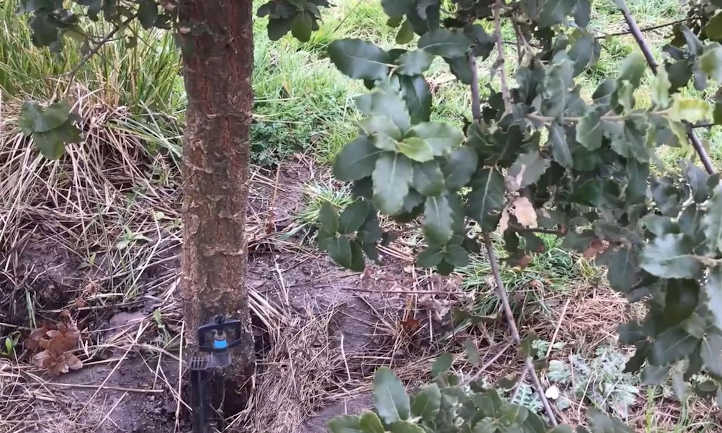
Once your orchard is established, there is really not much to do besides ensure enough even moisture in the grove, managing weeds, and managing pests. Most orchards need at least 3-7 years before they start to produce, so it can be a bit of a wait.
During this time, the largest time commitment could be pest-related. It’s important to go after pests that target your recently planted trees such as gophers, or ones that may eat your precious fungal primordia like slugs. Deer can eat saplings before snows melt and coyotes chew on irrigation lines in pursuit of water. Managing these pests is integral to managing the health of your truffles. Try to walk your groove once per week to look for pests.
Additionally, with each spring, remove any weeds or grass that form around the base of the tree. Growing truffles require that sunlight can reach the base of their tree. Your crop of truffles needs that sunlight to hit the ground to trigger their growth.
Avoid using pesticides on the ground at the base of the trees or over your irrigation system. Growing truffles require that their primordia stay alive even when you’re not harvesting. Spraying chemicals can kill the truffle and hurt your tree’s health. Clear the area around the base of the trees, make sure that the ground is free of weed to the drip line. Over the years, you will have less and less grass to clear as a brule, or clear earth area, forms underneath the tree. This is a sign that the fungus has colonized the roots extensively and is getting ready to produce.
Soil
The truffle fungus thrives in well-draining, light soils with a soil pH between 7.5-8. Avoid excessive walking, tractor use, or animal grazing among your inoculated trees. While truffle spores need humans to spread themselves, excessive compaction inhibits growth.
Propagation
Truffle inoculation is done by taking a fully grown truffle and blending it with water. This mixture is then ‘fed’ to the root zone of tree saplings in a growing medium. This isn’t always successful however, it is necessary to look under a microscope at some of the tree roots to see if the root zone has been successfully inoculated.
Harvesting and Storing
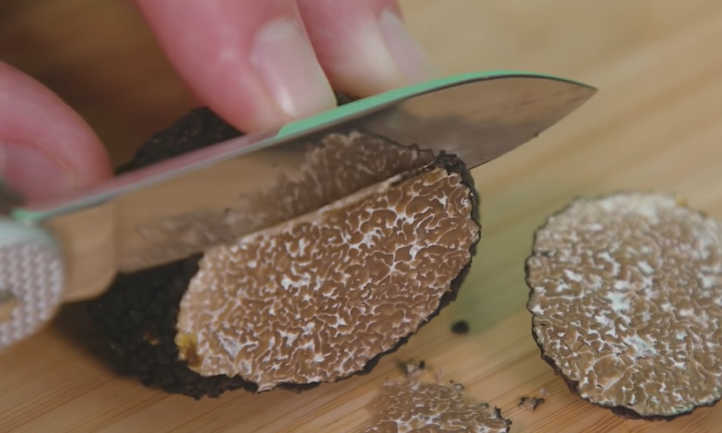
Truffle hunting is an art often performed alone or with your dog. While truffles put off a pungent aroma that can be smelled from far away, locating the exact position underground can be somewhat difficult without the scent triangulation capabilities of a trained truffle dog.
Harvesting
The growing truffles are best located by trained truffle dogs. After having been trained to do so, they’ll sit right above the truffle with their paw on it, and their companion will carefully dig through the soil to find the ripe truffle. Fill the soil when done and move on to your next hunt.
Alternatively, you can rake at the roots of a tree to find truffles. However, this method is used less often as it can result in unripe truffles that are then wasted.
Storing
When harvested directly from an orchard can last up to a week, but when bought from a local supplier will last just a day or two. All species of this tasty spore deteriorate within one 5-7 days of harvesting, so enjoy quickly!!
Frequently Asked Questions

Q: How long does it take to grow truffles?
A: Growing a truffle orchard can take up to 15 years to fruit, but it’s possible for them to produce in around 5 years if managed well.
Q: How hard is it to grow truffles?
A: It can be quite difficult to grow truffles, especially because of the years-long delay in production.
Q: Is it possible to grow truffles indoors?
A: No.
Q: Where do truffles grow in the US?
A: Truffles grow all over the US, from Oregon to Texas to Arkansas. More than anything they need proper care as that determines the success rate.

